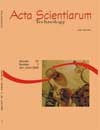Sewage sludge and petrochemical residue application effects on maize culture in soils of the state of Paraná
DOI:
https://doi.org/10.4025/actascitechnol.v20i0.3115Keywords:
lodo de esgoto, resíduo petroquímico, cultivo do milho, macronutrientesAbstract
The potentiality of two organic residues as macronutrient sources in soils was evaluated in a greenhouse experiment. The treatments consisted of one dose (38t.ha-1) of petrochemical residue and sewage sludge both neutralized by CaO + MgO at 3:1 ratio. Maize (Zea mays L.) was the reference plant. After 30-day seeding, the aerial parts of the plants were cut, dried at 70ºC till constant weight was obtained, then weighted and ground. Analysis was undertaken with nitroperchloric digestion. Macronutrient levels in soils and plants were determined by atomic absorption spectrometry. The results showed that the production of dry matter was higher when sewage sludge was used. Macronutrient levels in red latosol were higher than those of deep red latosol and red podzol respectively. In the aerial parts of maize plants collected in the soil treated with the sewage sludge the concentrations of the macronutrients K, N, Ca, S and P were higher than in the other treatments. The petrochemical residue caused the highest C:N ratio and the sewage sludge caused the highest Ca:Mg ratio.Downloads
Download data is not yet available.
Downloads
Published
2008-05-13
How to Cite
Gobbi, M. A., Pigozzo, A. T. J., Lenzi, E., & Luchese, E. B. (2008). Sewage sludge and petrochemical residue application effects on maize culture in soils of the state of Paraná. Acta Scientiarum. Technology, 20, 437–443. https://doi.org/10.4025/actascitechnol.v20i0.3115
Issue
Section
Chemistry
License
DECLARATION OF ORIGINALITY AND COPYRIGHTS
I Declare that current article is original and has not been submitted for publication, in part or in whole, to any other national or international journal.
The copyrights belong exclusively to the authors. Published content is licensed under Creative Commons Attribution 4.0 (CC BY 4.0) guidelines, which allows sharing (copy and distribution of the material in any medium or format) and adaptation (remix, transform, and build upon the material) for any purpose, even commercially, under the terms of attribution.
Read this link for further information on how to use CC BY 4.0 properly.











8.png)




